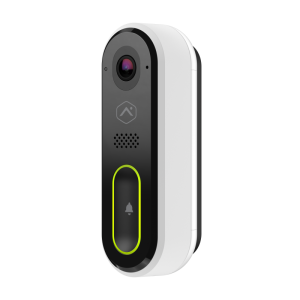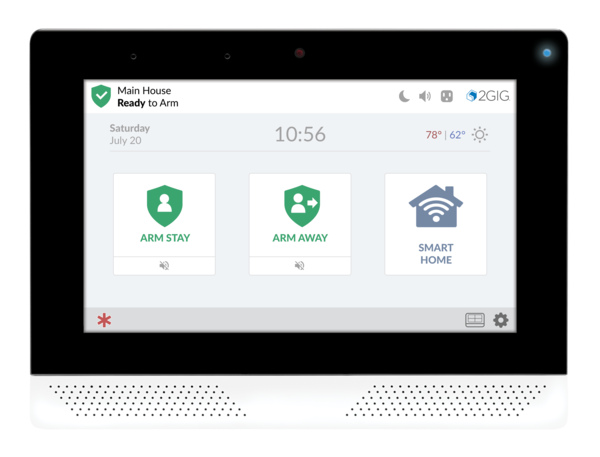2GIG GC3e Now $189.99 While Supplies Last!
PostedUpdate 12/30/21: The 2GIG GC3e has been discontinued and is no longer available. The 2GIG Edge w/ AT&T LTE or the 2GIG Edge w/ Verizon LTE have replaced it.
In an effort to clear out existing stock, the 2GIG GC3e Alarm Panel is now available at the bargain price of $189.99. This is an excellent chance to get a modern and reliable alarm panel for your home or business at a super low price. Act quickly, because supplies will run out very soon!
 We announced earlier this month that the 2GIG GC3e was discontinued. However, due to existing stock, the GC3e Panel is effectively back from the dead for one final run. Once the limited stock runs out, the 2GIG GC3e will be discontinued forever. Room needs to be made for newer panels, so we're offering the 2GIG GC3e for the low price of $189.99. This is a rare opportunity to get a great alarm panel to build around. It can certainly fulfill all of your security and smart home automation needs once you get it set up and running!
We announced earlier this month that the 2GIG GC3e was discontinued. However, due to existing stock, the GC3e Panel is effectively back from the dead for one final run. Once the limited stock runs out, the 2GIG GC3e will be discontinued forever. Room needs to be made for newer panels, so we're offering the 2GIG GC3e for the low price of $189.99. This is a rare opportunity to get a great alarm panel to build around. It can certainly fulfill all of your security and smart home automation needs once you get it set up and running!
The GC3e is fantastic for alarm monitoring. Just add either a 2GIG LTEA-A-GC3 AT&T LTE Communicator or a 2GIG LTEV1-A-GC3 Verizon LTE Communicator, and you will be able to connect the GC3e with the Alarm.com Servers for monitoring service. Since the 2GIG GC3e already has an internal WIFI card, adding the cellular communicator will make it into a dual-path system that will stay monitored even if one path goes down or becomes unavailable. Alarm.com requires cellular connectivity, so you will need a monitoring plan that includes cellular communication, such as an Alarm Grid Gold Plan (Self or Full).
Although the 2GIG GC3e doesn't support more advanced features like Bluetooth Disarming and Facial Recognition Disarming, the GC3e does support the robust lineup of 2GIG eSeries Encrypted Sensors. You can also supplement those encrypted sensors with non-encrypted sensors from the 2GIG 345 MHz Series and the Honeywell 5800 Series for good measure. The panel also has an integrated Z-Wave Plus controller so that you can start building a smart home network to make your life more convenient.
Overall, the 2GIG GC3e is an outstanding choice if you want more of a simple, no-frills panel that is still unmistakably modern and offers all the remote access and function through Alarm.com. If you do want something more advanced, than the 2GIG GC3e's effective replacement, the 2GIG Edge is available in AT&T LTE and Verizon LTE variants. Both the GC3e and the Edge connect with the same Alarm.com platform, and both offer the same sensor compatibility. The main benefit to going with the Edge is that you get access to some more advanced features, such as the aforementioned Bluetooth Disarming and Facial Recognition Disarming. If you don't mind missing out on those features, then the 2GIG GC3e is basically just as good. Both systems feature very similar menus and user interfaces (UIs), so if you know one, then you pretty much already know the other!
In addition, we are also offering special pricing on 2GIG GC3e System Kits. Each kit includes a cellular communicator for getting the system monitored a Honeywell LT-Cable for providing power, one (1) 2GIG PIR1e-345 Motion Sensor, and either three (3) or ten (10) VERSA-2GIG Door and Window Contact Sensors. Just decide whether you want AT&T LTE or Verizon LTE, and also whether you want three (3) door and window sensors or ten (10) door and window sensors. Then find the corresponding kit below. Hurry, before time runs out!
- 2GIG GC3e 3-1 Kit w/ AT&T LTE
- 2GIG GC3e 10-1 Kit w/ AT&T LTE
- 2GIG GC3e 3-1 Kit w/ Verizon LTE
- 2GIG GC3e 10-1 Kit w/ Verizon LTE
Remember, once supplies of the 2GIG GC3e run out, then the system is gone forever. If you have any questions about the GC3e, or any of the other security systems on our website, or if you want to speak with a security system expert who can help you build the perfect setup for your home or business, then please do not hesitate to send an email to our dedicated team at support@alarmgrid.com. We're here to check your emails from 9am to 8pm ET M-F. Whether you go with the 2GIG GC3e, its replacement, the 2GIG Edge, or a different system entirely, we will be there to help you every step of the way. Thank you for reading the Alarm Grid Blog, and we will be back with more news and promotions real soon!






 1.
1. 






